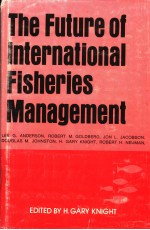

THE FUTURE OF INTERNATIONAL FISHERIES MANAGEMENTPDF电子书下载
- 电子书积分:11 积分如何计算积分?
- 作 者:H.GARY KNIGHT
- 出 版 社:
- 出版年份:2222
- ISBN:
- 页数:253 页
Ⅰ.International Fisheries Management: A Back-ground Paper—H. Gary Knight 1
A.History 1
1.Pre-1958 1
2.The 1958 and 1960 Law of the Sea Con-ferences 6
3.State Practice, 1945-1974; the Existing System 8
4.Fisheries, the Current Law of the Sea Negotiations, and the Third United Nations Conference on the Law of the 12
B.Issue Identification 15
1.Objectives of Fisheries Management 15
2.Conservation 23
3.Allocation 27
C.Positions and Interests on Fisheries in the Law of the Sea Negotiations 37
1.The United States Fishery Proposal and Its Revision: The “Species” Approach 37
2.Proposals of Distant Water Fishing Na-tions 39
3.Broad Coastal State Jurisdiction Pro-posals 41
D.Procedural Aspects of Developing Fishery Policy 43
1.Pros and Cons of the Third Conference Format 43
2.The Constitutive versus the Substantive Approach 46
3.International Agreement versus Custom-ary International Law Processes 48
E.Conclusion 49
Ⅱ. Future Fisheries Technology and the Third Law of the Sea Conference—Jon L. Jacobson 51
A.Introduction 51
B.A Short History of Fishing Methods 55
C.Future Fishing Technology/Law of the Sea Implications 60
1.Location of Fish 61
2.Capture of Fish 65
3.Processing of Fish 72
4. Vessel Construction and Navigation 74
D.General Conclusions: Fishing Technology 75
1.Increased Efficiency 75
2.Need for Increased Cooperation: “Fish Forecasting” Services 79
3.Sophisticated-Gear Conflicts 82
4.The Passive-Gear Trend 82
E.The Future Impact of Aquaculture 86
F.Conclusion: Flexibility is the Key 87
Ⅲ. Multinational Investment in Fisheries: Implica-tions for International Agreements on Living Marine Resources—Robert H. Neu-man 93
A.Introduction 93
B.Who Invests and Why 93
C.Developed Country Investment Activity 95
1. Brief Review of World-wide Investment Activity 95
2.What Such Activity Implies 99
D.Possible Methods of Regulating the Flow of Multinational Funds 99
1.Coastal State Management 100
2.International Management 100
3.Regional Management 101
E.Conclusion 101
Ⅳ.Some Treaty Law Aspects of a Future Interna-tional Fishing Convention—Douglas M.Johnston 103
A.Introduction 103
1.The Status of the Vienna Convention on the Law of Treaties 103
2.Applicability of the Vienna Convention to Existing and Future Fishing Trea-ties and Fishery Agreements 106
3.Applicability of a Future International Fishing Convention to Existing Fish-ery Agreements 110
B.General Effect of the Vienna Convention on a Future International Fishing Con-vention 111
1.Some Anticipated Features of a Future International Fishing Convention 111
2.Problems of Conclusion and Entry Into Force 113
3.Problems of Observance, Application and Interpretation 114
4.Problems of Amendment and Modifica-tion 116
5. Problems of Invalidity, Termination and Suspension 117
C.Some Regional Treaty Consequences of a Fu-ture International Fishing Convention 120
1.Classification of Fishing States 120
2.Classification of Fishing Regions of the World 123
3.Potential Treaty Law Problems in “Coastal Fishing Regions” 124
4.Potential Treaty Law Problems in “In-clusive Fishing Regions” 130
5.Potential Treaty Law Problems in “Fishing Conflict Regions” 138
Ⅴ.Criteria for Maximum Economic Yield of an In-ternationally Exploited Fishery—Lee G.Anderson 159
A.Introduction 159
B.Summary of the Economic Aspects of Nation-al Fisheries Management 160
1.Maximum Economic Yield 160
2.Open Access Equilibrium Yield 162
3.Maximum Sustainable Yield 164
C.Analysis of “MEY” of an Internationally Ex-ploited Fishery 167
1.A Two Country Model 167
2.Criteria for Achieving an International “MEY” 172
D.Problems of Application of “MEY” Analysis 174
E.Various Proposals Regarding the Economic Rationale of Living Marine Resources 177
1.The United States Position 178
2.The “Patrimonial Sea” Concept 180
3.The Japanese and Soviet Positions 180
F.Summary 181
Ⅵ.Ends and Means: The Role of Enforcement Anal-ysis in International Fisheries Regulation —Robert M. Goldberg 183
A.Introduction 183
B.The Elements of Enforcement 187
1.Who Enforces 187
2.Goals in Enforcement 191
3.The Enforcement Process 193
4.Direct Factors in Enforcement 198
5.Indirect Factors of Enforcement 200
6.Types of Enforcement Action 206
7.Results of Enforcement 207
C.Table of Values and Conclusion 210
Ⅶ. Principles For a Global Fisheries Management Regime Preface 213
A.Principle No. 1 Objectives 214
B.Principle No. 2 Right of Management En-tity 216
C.Principle No. 3 Global Fisheries Monitor-ing Agency 221
D.Principle No. 4 Rationale for Global Regime 225
E.Principle No. 5 Goal of Management Regime 227
F.Principle No. 6 Dispute, Avoidance and Settlement 229
G.Principle No. 7 Actions Inconsistent with Global Fisheries Treaty 232
H. Principle No. 8 Enforcement 234
Names of Members of the Working Group on Living Marine Resources 237
Index 239
- 《洋务学堂》(美)毕乃德(Biggerstaff,Knight)著;曾钜生译 1993
- 《小艾在巴黎》(美)汤普森(Thompson,K.)著;(美)奈特(Knight,H.)绘;韩卉译 2005
- 《风险、不确定性与利润》(美)弗兰克·H. 奈特(Frank H. Knight)著;安佳译 2006
- 《风险、不确定性和利润》(美)富兰克·H. 奈特(Frank H. Knight)著;王宇,王文玉译 2005
- 《小艾来了》(美)汤普森(Thompson,K.)著;(美)奈特(Knight,H.)绘;韩卉译 2005
- 《AutoCAD 12参考手册》Robert Knight,William Valaski著;穆之,木杉译 1994
- 《教育哲学导论》GEORGE R. KNIGHT著 2010
- 《老人心理治疗》Bob G. Knight原作 2001
- 《伯克利物理学教程 SI版 第1卷 力学 英文版》(美)C.基特尔(CHARLESKITTEL),(美)W.D.奈特(WALTERD.KNIGHT),(美)M.A.鲁德尔曼(MALVINA.RUDERMAN)著;(美)A.C.亥姆霍兹(A.CARLHELMHOLZ),(美)B.J.莫耶(BURTONJ.MOYER)修订 2014
- 《SQL Server 2000高级DBA指南》(美)Brian Knight著;李明,欧阳宇译 2003
